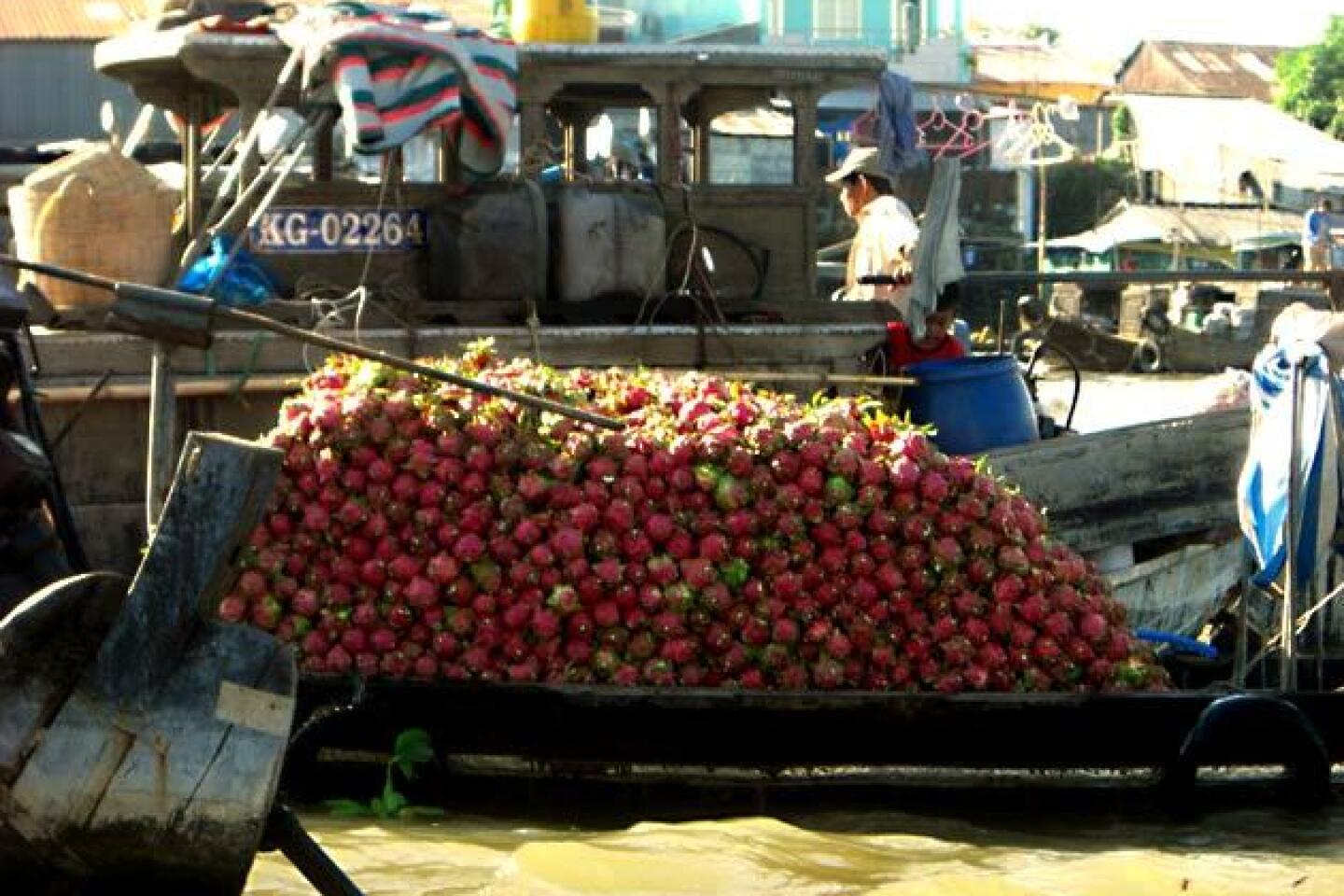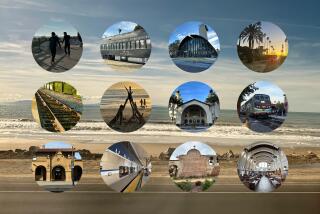Reunification Express offers slow ride between Hanoi and Ho Chi Minh City
- Share via
Reporting from Ho Chi Minh City, Vietnam — The voice was guttural and raspy, the language deep and tonal.
“Come and get your rice!” sang the man, a steward for Vietnam’s national rail service. He wore a light blue apron over his blue button-down shirt and pushed a silver metal cart laden with cardboard packages of rice, scallions, sprouts and spring rolls. Behind him, a slender woman pushed a similar cart stocked with Bia Ba Ba Ba (333 Beer), thit kho bo (bagged beef jerky), shrimp chips and bottled water. Outside our window, a tableau of steep emerald-green mountains whooshed by as the train chugged through rice paddies, swamps and villages.
Our musty car was filled with families on vacation or off to see relatives. They wore T-shirts sporting slogans in broken English and snacked on bowls of noodle soup as their eyes fixed on the car’s several televisions, which showed translated versions of Discovery Channel’s “MythBusters” and reels of comedy clips that resembled “America’s Funniest Home Videos.”
This was not your usual train ride. Two friends and I were on the Reunification Express, which crawls down Vietnam’s long, magnificent coastline between Hanoi in the north and Ho Chi Minh City, better known as Saigon, in the south, a distance of 1,072 miles.
We were in Hanoi for the summer, working at a media organization called VietNamNet and decided to take a week to explore the country we were temporarily calling home. Flying was too expensive, and the bus too touristy.
We wanted to travel the Vietnamese way, so we set off for Ga Ha Noi, Hanoi’s train station, to get our tickets. We soon learned that in Vietnam, one buys tickets the way Americans buy cold cuts at a deli. You take a ticket and wait until its number is displayed on a small analog screen. When our number flashed, we asked our teller, “Chi co noi tieng Anh khong,” or “Do you speak English?” She responded, “Yes,” and we asked for a sleeper car to Nha Trang, a popular beach resort 800 miles down the coast.
Then came the bad news: Because it was the height of tourist season, all sleeper cars were already booked, so we grabbed an air-conditioned soft-seat car, something like an Amtrak car. (A word to the wise: Try to reserve your spot in a sleep car least 48 hours before you set out on a long rail trek in Vietnam. We booked the day before. You can get tickets at the station in advance, or most hotels will be happy to book your ticket for you with a slight commission.) Our tickets cost us about $37.
We had mapped out a loose itinerary. Without too much time off from work, we decided we would hit Nha Trang, said to be the most idyllic and popular beach destination in Vietnam, then move on to Ho Chi Minh City, eight hours to the southwest.
We left early the next afternoon on the SE5 train (southbound trains have odd numbers, northbound trains have even) and were quickly roaring through thick jungle and small towns with tin-roofed shacks, open cafes and crisp, new VinaPhone retailers, all built into Vietnam’s wet, swampy terrain. By nightfall we had reached Vinh, the first major city on the trip and the first place where we saw the turquoise waters and mossy cliffs the train would hug for the rest of the ride.
Unfortunately, we traveled most of the coast by night, able to see the shimmering water and dramatic topography by only the moon and illuminated buoys. If one wishes to take in the breathtaking coast and rugged hills by day, take the SE3 train, which leaves Hanoi at 11 p.m., reaching the beginning of the astonishing central coast about 7 a.m.
By late that night we had crossed the now-invisible border between the north and south and were coasting into Hue, a majestic, well-preserved city that saw heavy fighting during the Vietnam War (damaged areas have been rebuilt).
As we glided past limestone cliffs, my friend and I did our best to socialize with our neighbors, a family from a Hanoi suburb off to Nha Trang for a beach getaway.
As the only Westerners on the train, we drew some attention and friendly attempts to show us how to eat certain foods. Soon we were munching shrimp chips (not my favorite) and a cucumber-like fruit called oy, with a Vietnamese mother, her teenage son, two teenage daughters, and a young, mischievous son who poked me and grinned ecstatically.
I conversed in my shaky Vietnamese and gave the poking-grinning boy a Red Sox hat, which tickled the crowd. We made them paper airplanes with my friend’s dollar-bill stationery, drawing a frenzy of riders who grabbed at what they soon discovered was just paper.
We were big hits, as the family — who became our friends — invited us to dine with them in Nha Trang and suggested that we should marry their daughters. I wound up with a Michael Jackson-style fedora courtesy of the eldest son, and they wound up with our e-mail addresses and some quarters and nickels as keepsakes.
If creature comforts, luxury or anything resembling a familiar travel experience are expected, taking Vietnam Railways any distance is not advisable. But if one wants to see Vietnam from the perspective of its people and be treated to mesmerizing scenery and an enriching cultural experience, riding the Reunification Express is a great way to transit the coast.
The trains are slow compared with those in much of the world, averaging about 30 mph, meaning the ride to Saigon takes about 34 hours, depending on delays. And although the seats are as comfortable as those in an American airplane, they won’t win any awards for luxury. The cuisine is certainly authentic. If you (and your stomach) can handle roast chicken, rice porridge and other Vietnamese staples from the train’s kitchens, sample the fare. If you don’t feel daring, there are plenty of snacks available in the dining car and at the stops, usually at about two-hour intervals.
Traveling the distance to Saigon in the Express’ finest offering, a four-person cabin in an air-conditioned “soft” sleeper car, will cost $70 to $75. The hard sleeper (wooden bunks instead of cushier beds) will be about $55.
Unfortunately, there is no way to buy a combination pass as in Europe. If you want to stop and get off, you must buy a new ticket to get back on.
Important stops along the way include Vinh; Hue; Da Nang, Vietnam’s third-largest city, an increasingly important business center and the departure point for the historic city and tailoring capital of Hoi An; and Nha Trang, Vietnam’s largest beach party town and a destination for scuba diving and cave exploration.
The Reunification Express is not about trying to pack in a frantically crammed tour of Vietnam. Quite the opposite. It is about crawling the spindly coast and absorbing its aesthetics, varied terrain and welcoming people.
More to Read
Sign up for The Wild
We’ll help you find the best places to hike, bike and run, as well as the perfect silent spots for meditation and yoga.
You may occasionally receive promotional content from the Los Angeles Times.







